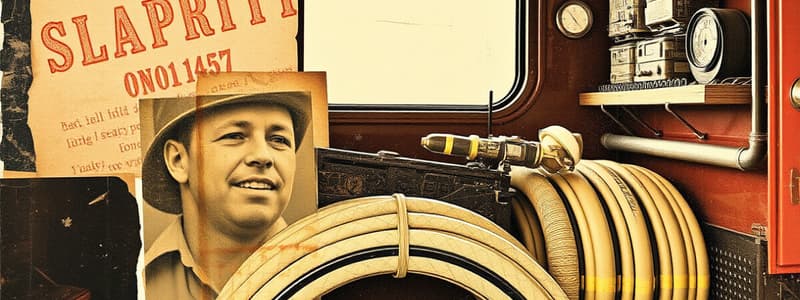Podcast
Questions and Answers
What is required when hard suction is not in use?
What is required when hard suction is not in use?
- It needs to be fastened and secured to the apparatus. (correct)
- It should be disconnected from the apparatus.
- It must be left unfastened.
- It should be stored in a pressurized water source.
What must a hose storage area be equipped with per NFPA 1901 requirements?
What must a hose storage area be equipped with per NFPA 1901 requirements?
- An automatic deployment mechanism.
- A manual release lever only.
- Only a cover for the hose.
- A positive means to prevent unintentional hose deployment. (correct)
What is the first step in maintaining fire hose after use?
What is the first step in maintaining fire hose after use?
- Store the hose immediately.
- Inspect for leaks solely.
- Clean all hose after use. (correct)
- Leave it on the apparatus to dry.
How should hoses be handled to minimize damage?
How should hoses be handled to minimize damage?
What should be used to prevent hose abrasion from ground vibration?
What should be used to prevent hose abrasion from ground vibration?
What type of water conveyance method is inappropriate for hard suction hoses?
What type of water conveyance method is inappropriate for hard suction hoses?
What is a recommended practice to extend the life of fire hose?
What is a recommended practice to extend the life of fire hose?
What action should be avoided when operating nozzles?
What action should be avoided when operating nozzles?
What is the maximum service test pressure for 1½” forestry fire hose?
What is the maximum service test pressure for 1½” forestry fire hose?
How long must the hose hold the service test pressure during testing?
How long must the hose hold the service test pressure during testing?
What is the correct rate to increase pressure during a hose test?
What is the correct rate to increase pressure during a hose test?
Which method is crucial to avoid damaging the pump during hose testing?
Which method is crucial to avoid damaging the pump during hose testing?
What should be done if a rupture occurs in the fire hose during testing?
What should be done if a rupture occurs in the fire hose during testing?
What is the maximum discharge pressure allowed through the Tank Fill valve during testing?
What is the maximum discharge pressure allowed through the Tank Fill valve during testing?
What must be inspected for leaks while the hose is at service test pressure?
What must be inspected for leaks while the hose is at service test pressure?
What type of fire hose must be service tested to a maximum of 250 psi?
What type of fire hose must be service tested to a maximum of 250 psi?
What action should be taken to ensure there is no air in the hose line before testing?
What action should be taken to ensure there is no air in the hose line before testing?
What is the maximum service test pressure for a 5” fire hose?
What is the maximum service test pressure for a 5” fire hose?
What should be done if leakage is detected at a coupling during a hose test?
What should be done if leakage is detected at a coupling during a hose test?
What marking is required on the hose after conducting a service test?
What marking is required on the hose after conducting a service test?
Which type of fire hose must be service tested to 400 psi?
Which type of fire hose must be service tested to 400 psi?
Why is it crucial to remove air from the hose before pressurization?
Why is it crucial to remove air from the hose before pressurization?
What is the service test pressure for 1¾” fire hose?
What is the service test pressure for 1¾” fire hose?
How should personnel behave during the hose testing process?
How should personnel behave during the hose testing process?
Flashcards are hidden until you start studying
Study Notes
Hard Suction and Hose Covers
- Hard suction must be secured to the apparatus when not in use to prevent movement during transport.
- Hard suction hose cannot be connected to a pressurized water source at any time.
- All hose beds and storage areas on PBCFR apparatus require a cover and securement system per NFPA 1901 standards to prevent unintentional deployment.
General Care of Fire Hose
- Proper maintenance and care of fire hoses are essential for performance and longevity.
- Clean hoses after each use; if contaminated, wash with warm water and mild detergent.
- Avoid dragging hoses over rough surfaces, placing them near exhausts, or allowing vehicles to pass over them.
Hose Maintenance Practices
- Use hose ramps and chafing blocks to prevent damage from abrasion and vibrations.
- Open and close nozzles and discharge gates slowly to avoid water hammer effects.
- Ensure hoses are fully charged with water and all air is expelled to prevent hose whip during bursts.
Testing Procedures
- Pressure testing involves applying 45 psi (± 5 psi) and checking for leaks at each coupling.
- Mark hoses with a permanent marker at the back of the coupling for monitoring slippage during tests.
- Service test pressures vary:
- 5” fire hoses: 200 psi max
- 3” fire hoses: 300 or 400 psi depending on age
- 2½” Hi-Combat: 300 psi
- 2½” Key Tru-ID: 400 psi
- 1¾” fire hoses: 300 psi
- 1½” forestry hoses: 300 psi
- Booster Reel hoses: 250 psi
Test Conditions and Cautions
- Pressure must be increased slowly at no more than 15 psi per second.
- Hoses should maintain test pressure for 3 minutes.
- Water must circulate through the pump during testing to avoid damage; open Tank Fill valve just enough to move water without exceeding 100 psi.
- Inspect hoses for leaks while under test pressure and keep personnel a safe distance from the hose lines to avoid injury from ruptures.
Studying That Suits You
Use AI to generate personalized quizzes and flashcards to suit your learning preferences.




